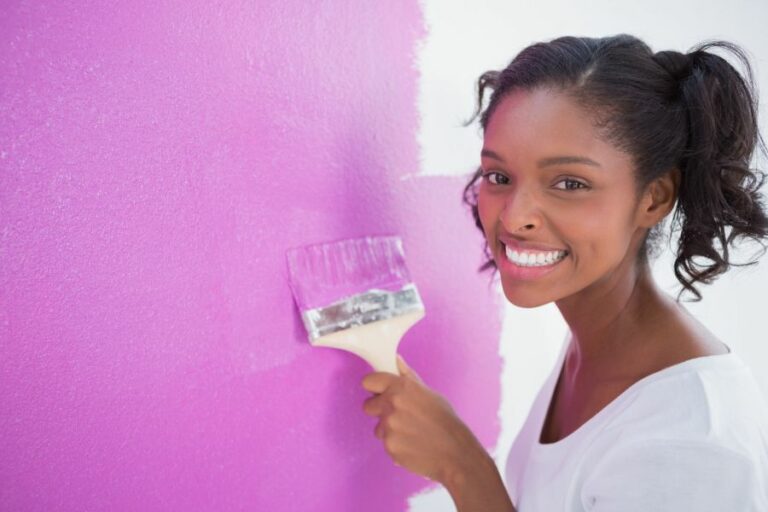Non-Toxic Oil-Based Indoor Paint Alternatives. What Pros Say
Are you searching for a safer, more eco-friendly solution to traditional oil-based indoor paints? You’ve come to the right place! I understand your concerns about the potential health hazards and environmental impacts of using conventional oil-based paints, and we’re here to help. I have researched and gathered the best non-toxic alternative solutions that will deliver the same high-quality results, taking the guesswork out of your next paint project.
Non-toxic oil-based indoor paint alternatives:
Non-toxic oil-based indoor paint alternatives include water-based paints like acrylic and latex and natural paints such as milk and clay. These eco-friendly options have low or zero VOCs, are safer for indoor air quality, and contribute to a healthier environment.

Looking for eco-friendly and safe alternatives to traditional oil-based indoor paints? I’ve got you covered! Read on to discover a variety of non-toxic options that benefit not only your home but the environment as well. Let’s create healthy, beautiful spaces together!
Contents
- 1 Eco-friendly Alternatives to Indoor Oil-Based Paints
- 2 Top Environmentally Friendly Substitutes for Oil-Based Paint
- 3 Are There Low-VOC Options for Oil-Based Paints?
- 4 Examining Indoor Safety of Using Oil-Based Paints
- 5 The Reason Behind Banning Oil-Based Paint
- 5.1 • A Brief History of Oil-Based Paint
- 5.2 • Environmental Impact: Volatile Organic Compounds (VOCs)
- 5.3 • Regulatory Action: Restricting VOC Content in Paints
- 5.4 • Health Concerns: Exposure to Toxic Chemicals and Allergens
- 5.5 • Alternatives to Oil-Based Paint: Embracing Green Technologies
- 5.6 • In Conclusion: The Benefits of Shifting Away from Oil-Based Paint
Eco-friendly Alternatives to Indoor Oil-Based Paints
Many individuals are becoming more conscious of the impact of their choices on the environment and their health.
An area of particular concern is the use of oil-based paints in indoor spaces. These paints can contain potentially hazardous chemicals, some of which may enhance long-term health complications.
Choosing non-toxic oil-based indoor paint alternatives can significantly improve indoor air quality and create a healthier environment.
• Water-Based Paints: A Healthier Alternative
Water-based paints are known for their low levels of toxic emissions (VOCs). Because of their water content, they are more environmentally friendly than oil-based paints. They are easier to clean, dry faster, and emit less odor, which can greatly help those with allergies or chemical sensitivities.
– Acrylic Paints
Acrylic paints are one of the most popular water-based paint options. They are odorless and dry quickly, which makes them an ideal alternative for interior painting projects. Additionally, they are durable and resistant to yellowing or cracking over time.
For more information on acrylic paints and their non-toxic properties, visit the EPA’s Sustainable Material Management page.
– Latex Paints
Latex paints are also water-based, making them easy to clean up and a more environmentally friendly choice. They are available in a wide variety of finishes and can withstand less humidity, making them perfect for bathrooms and kitchens.
• Natural Paints: The Eco-Friendly Choice
Natural paints are made from raw, natural ingredients such as water, plant oils, chalk, and clay. They are free from synthetic chemicals and typically have zero or very low VOCs.
– Milk Paint
Milk paint is made from milk proteins (casein), limestone, and natural pigments. This paint has zero VOCs, is biodegradable, and has a strong adherence to various surfaces, making it a suitable option for many interior painting projects. Milk paint is also known for its vibrant colors and unique, rustic finish.
– Clay Paint
Clay paint is a natural paint option made from clay, water, and natural dyes. It offers excellent coverage and a subtle, earthy texture. Clay paint has the added benefit of helping to maintain a balanced indoor humidity level as it can absorb excess moisture and release it when the air is too dry.
• Environmentally-Safe Paint Removal
If you are planning to repaint a space with non-toxic alternatives, it is essential to remove old paint in an eco-friendly manner. Traditional paint strippers often contain harsh chemicals that can be harmful to your health and the environment.
Consider using non-toxic paint strippers like Soy Gel or Citristrip. These products are made from natural ingredients and are safe and effective alternatives for removing old paint and preparing surfaces for new paint application.
• Tips for Choosing Non-Toxic Oil-Based Paint Alternatives
- Research paint brands and look for those committed to sustainable and eco-friendly practices.
- Check labels for VOC content – opt for zero or low-VOC options.
- Look for third-party certifications like Green Seal, Greenguard, or Scientific Certification Systems (SCS).
- Choose natural pigments over synthetic dyes, avoiding paints containing heavy metals like lead or mercury.
- Take the time to sample various alternatives and consider the specific requirements of your painting project.
In conclusion, selecting non-toxic oil-based indoor paint alternatives can improve indoor air quality and create a healthier environment, all while being eco-friendly.
With an increasing number of viable options on the market, individuals can now find the perfect paint for their needs without compromising health or sustainability.
Top Environmentally Friendly Substitutes for Oil-Based Paint
When considering an alternative to oil-based paint, water-based paint is the most popular and practical option. This eco-friendly choice is more versatile than traditional oil-based paints and offers several advantages, ranging from easier application and drying to better overall performance.
Through continuous improvements and advancements in technology, water-based paints have become the preferred choice for professional painters and DIY enthusiasts alike.
• Advantages of Water-Based Paint
Water-based paints have a number of benefits that make them the ideal alternative to oil-based paints. Some of the key advantages include:
– Faster Drying Time
Water-based paints dry faster than oil-based paints, which is especially beneficial when working on projects with tight deadlines.
They generally dry within one to six hours, whereas oil-based paints can take up to 24 hours to cure. This means that multiple coats can be applied in a shorter period without negatively affecting the final result.
– Easier Cleanup
Water-based paints are significantly easier to clean up after use than oil-based paints. Since they are water-soluble, brushes, rollers, and other tools can be easily cleaned with water and mild soap, eliminating the need for potentially harmful chemicals during the clean-up process.
– Lower VOC Content
Water-based paints have lower levels of volatile organic compounds (VOCs) compared to oil-based paints. VOCs are chemicals released into the air as paint dries, which can lead to poor indoor air quality and health issues.
The lower VOC content in water-based paints contributes to a healthier and more environmentally friendly painting experience.
The United States Environmental Protection Agency has additional information on the impact of VOCs on indoor air quality.
– Better Color Retention
Water-based paints have longer-lasting and more consistent color retention than oil-based paints. This means that the colors are less likely to fade or yellow over time, providing better long-term results for your paint projects.
– Better Adhesion
Water-based paints are known for their excellent adhesion properties on various surfaces, including wood, metal, and masonry. This ensures a durable and long-lasting paint job that resists peeling, cracking, and blistering.
• Choosing the Right Water-Based Paint
When selecting water-based paint, it’s essential to pay attention to the specific type and formulation to ensure the best performance for your project. Here are some recommendations:
– Acrylic Paint
For a versatile and durable alternative to oil-based paint, I recommend acrylic paint. Acrylics have the ability to adhere to various surfaces and offer excellent color retention. They are also resistant to moisture, making them ideal for both indoor and outdoor applications.
– Latex Paint
Latex paint is another type of water-based paint that has gained popularity for its ease of use and fast drying time. While not as durable as acrylic paint, latex paint is still an excellent choice for interior walls and surfaces that do not require the same level of protection as exteriors or high-traffic areas.
– Alkyd-Modified Paint
This hybrid paint combines the best features of both oil-based and water-based paints in a single formulation. Alkyd-modified paint provides the durability and adhesion of oil-based paint while still offering the ease of use and low VOC content of water-based paint.
• Tips for Applying Water-Based Paint
To achieve the best possible results with water-based paint, follow these tips:
- Surface Preparation – Properly clean and prepare the surface to ensure optimal adhesion and a smooth finish. Remove any dirt, dust, or old paint, and ensure the surface is dry before starting.
- Priming – Use a compatible water-based primer to create a consistent and uniform base for the paint. This will improve adhesion and coverage.
- Application – Apply the paint using a high-quality brush, roller, or spray gun. Use multiple thin coats rather than a single thick coat to ensure even coverage and prevent drips or uneven texture.
- Drying Time – Allow each coat to dry thoroughly before applying additional coats or touching up any areas. Follow the manufacturer’s instructions for drying times to ensure the best results.
- Clean-Up – Clean brushes, rollers, and other equipment immediately after use, using water and mild soap. Proper cleaning and maintenance will extend the life of your painting tools and ensure they are ready for future projects.
In conclusion, water-based paint is an excellent alternative to oil-based paint due to its numerous benefits and superior performance.
By choosing the right type of water-based paint, following proper application techniques, and considering environmental factors, you can achieve long-lasting and high-quality results in your painting projects.
Alternative | Description | Advantages |
|---|---|---|
Water-based paint (Acrylic paint) | Paint where the binder is a mixture of water and acrylic polymer emulsion. | Low odor, fast drying, easy to clean, and environmentally friendly. |
Latex paint | Paint where the binder is a synthetic polymer similar to the natural latex derived from rubber trees. | Low odor, fast drying, excellent durability, less susceptible to yellowing, and easy to clean. |
Milk paint | Paint made from milk protein (casein), lime, and pigments. | Natural, non-toxic, breathable, and provides a unique finish. |
Chalk paint | Paint made with a mix of water, calcium carbonate, and pigments. | Unique finish, easy to distress, and good for decorative purposes. |
Are There Low-VOC Options for Oil-Based Paints?
The search for low Volatile Organic Compound (VOC) paint options can be a challenge, especially when it comes to oil-based paints.
• The Low VOC Challenge with Oil-Based Paints
Traditionally, oil-based paints are known for their durability, smooth finish, and resistance to wear and tear.
However, they come with a major downside: high VOC content. VOCs are chemicals that easily evaporate into the air at room temperature, causing adverse human health effects and contributing to air pollution.
Manufacturers have found it challenging to create low-VOC oil-based paints due to the nature of the oil base itself. Oil-based paints consist of resins, pigments, and solvents, which often contain high VOC levels to ensure proper drying and performance.
The difficulty lies in formulating an oil-based paint that maintains its desirable features while significantly reducing its VOC content.
• Limited Availability of Low VOC Oil-Based Paints
Despite the challenges, some manufacturers have managed to produce low-VOC oil-based paints. In recent years, the development of innovative technologies and the stringent implementation of environmental regulations have forced paint manufacturers to explore low-VOC alternatives to traditional oil-based paints.
Sherwin Williams, for instance, offers ProMar 200 Zero VOC Alkyd, which is an alkyd-based paint with a VOC content of less than 50g/L. Another example is Benjamin Moore’s Advance Waterborne Alkyd. But it is crucial to note that the availability of such products is limited and varies by location.
• Alternatives to Low VOC Oil-Based Paint
Considering the limited availability and potential shortcomings in performance, seeking alternative paint options is a sensible approach. There are eco-friendlier options available, such as water-based acrylic and latex paints.
These paints typically have lower VOC content compared to traditional oil-based paints while still providing good coverage, adhesion, and longevity.
– Water-based acrylic paints
Water-based acrylic paints have gained popularity in recent years due to their low VOC content and quick drying time. Also, these paints are resistant to weathering and yellowing, making them an ideal choice for both interior and exterior surfaces.
Water-based acrylics can be used to paint furniture, cabinets, walls, and more, offering an excellent finish and durability.
– Latex paints
Latex paints are another suitable alternative to oil-based paints. As they are water-based, they have less odor, lower VOC content, and faster drying times. Latex paint is easy to clean up, resistant to peeling and cracking, and maintains its color well over time.
Latex paints can be used for a variety of applications, including interior and exterior walls, ceilings, trim work, and more.
• Recommendations for Choosing an Eco-Friendly Paint
When selecting a paint for your projects, considering both its environmental impact and its performance is crucial. Here are some recommendations to help you make an informed decision:
- Opt for water-based paints, such as acrylic and latex, over oil-based options as they generally have lower VOC content.
- Check the paint label for its VOC content; aim for paint with VOC levels below 50g/L.
- Look for third-party certifications, such as Greenguard Gold or Green Seal, that guarantee the paint meets specific environmental and human health standards.
- Be mindful of local regulations, such as those imposed by the U.S. Environmental Protection Agency, to ensure that your chosen paint is compliant with safety requirements.
In conclusion, low VOC oil-based paint options exist but can be difficult to find, and their performance may not always be on par with traditional oil-based paints. For a healthier, eco-friendly solution, consider water-based alternatives, such as acrylic and latex paints.
These options offer excellent performance, lower VOC content, and meet environmental standards while providing a desirable finish for various applications.
Examining Indoor Safety of Using Oil-Based Paints
Oil-based paints have long been a popular choice for various painting projects due to their durability and rich, glossy finish. However, concerns about their potential health risks and environmental impact have led many people to question whether it is safe to use oil-based paint indoors.
• Understanding the Dangers of Oil-Based Paint
A primary concern when using oil-based paint indoors is the presence of volatile organic compounds (VOCs). VOCs are emitted as gases from certain solids or liquids, including many paints and solvents. Some VOCs may have short-term or long-term adverse health effects.
According to the United States Environmental Protection Agency, exposure to high concentrations of VOCs can lead to eye, nose, and throat irritation, headaches, and damage to the liver, kidney, and central nervous system.
The level of VOCs in oil-based paint is significantly higher than that found in water-based or latex paints. This is because the primary solvent used in oil-based paint, known as alkyd, is a significant source of VOC emissions.
This contributes to indoor air pollution, which can be particularly harmful in poorly ventilated spaces.
• Alternatives to Oil-Based Paint
Considering the potential health and environmental risks associated with oil-based paint, many people opt for alternative paint options when working on indoor projects. Some common alternatives include:
– Water-Based Paint
Also known as latex or acrylic paint, water-based paint has a lower VOC content compared to oil-based paint. Recent advancements in paint technology have led to water-based paints with similar durability and finish quality to oil-based paints.
– Low-VOC and No-VOC Paints
Many paint manufacturers now offer a range of low-VOC and non-VOC paint options. These products emit fewer harmful chemicals, making them a safer choice for indoor use.
Some low-VOC and non-VOC paints are also specially formulated to resist mold and mildew, which can further improve indoor air quality.
– Natural Paints
Made from biodegradable materials such as clay, lime, or plant-based oils, natural paints have minimal impact on indoor air quality and are environmentally friendly. However, these paints may not be as durable or have the same high-quality finish as other paint options.
• Safe Handling and Application of Oil-Based Paint
If using oil-based paint indoors is unavoidable, consider the following recommendations to minimize potential health and environmental risks:
– Proper Ventilation
Ensure that the area you will be painting is well-ventilated. Open windows and doors, and use fans to circulate air and disperse paint fumes. Taking these measures, in turn, reduces the concentration of VOCs in the indoor air.
– Use Protective Gear
Wear appropriate personal protective equipment (PPE) when handling and applying oil-based paint. This may include gloves, eye protection, and a properly fitted respirator with an organic vapor cartridge to minimize inhalation of harmful fumes.
– Choose Low-VOC Oil-Based Paint
Select a low-VOC oil-based paint if possible. These paints have lower solvent content and, consequently, lower VOC emissions. Always check the manufacturer’s label for information about VOC content and recommended safety measures.
– Proper Disposal
Dispose of used paint cans, brushes, and other painting materials responsibly. Contact your local waste management facility for guidelines on how to dispose of oil-based paint and related waste in your area. Note that some facilities may also offer paint recycling programs.
• Conclusion
While oil-based paint has its merits, particularly in terms of durability and finish quality, it’s essential to consider the potential health and environmental risks associated with its indoor use. With a range of alternative paint options available, selecting a safer product for indoor projects is easier than ever.
However, if you must use oil-based paint indoors, take the necessary precautions to minimize exposure to harmful fumes and chemicals. By following these recommendations, you can ensure a safer, healthier indoor painting experience.
The Reason Behind Banning Oil-Based Paint
• A Brief History of Oil-Based Paint
Oil-based paint has been used for centuries as an effective, durable, and visually appealing option for various painting applications. However, in recent years, several governments and environmental agencies have either banned or strongly discouraged the use of oil-based paints.
• Environmental Impact: Volatile Organic Compounds (VOCs)
One of the main reasons behind the ban on oil-based paint is the emission of volatile organic compounds (VOCs). VOCs are organic chemicals that easily evaporate into the air at room temperature, leading to air pollution and a range of health issues.
Oil-based paints contain high levels of VOCs, which contribute to smog and poor air quality.
When oil-based paints dry, they release VOCs into the atmosphere. These compounds can react with other air pollutants and form ground-level ozone, which is harmful to human health and the environment.
According to the United States Environmental Protection Agency (EPA), long-term exposure to high levels of VOCs can result in damage to the liver, kidneys, and central nervous system. Short-term exposure can cause eye, nose, and throat irritation, headaches, nausea, and dizziness.
Additionally, high levels of VOCs can contaminate groundwater sources, leading to water pollution. As a result of these environmental and health concerns, governments and environmental agencies have called for a reduction in VOC emissions from paints and other products.
• Regulatory Action: Restricting VOC Content in Paints
In the United States, governmental agencies such as the EPA and regional air quality management districts have adopted regulations to limit the VOC content in oil-based and other architectural coatings.
The South Coast Air Quality Management District (SCAQMD), for example, has established strict limits on the VOC content of various types of paints and coatings. Consequently, the use of oil-based paint in residential and commercial projects has significantly reduced in the US.
In the European Union, similar restrictions have been put in place to reduce VOC emissions from paint products. The European Union (EU) has set the maximum limit of VOC content in decorative paints and varnishes, which has led to a shift toward water-based and other low-VOC paint alternatives.
As other governments and regions become more environmentally conscious, we can expect further regulations on VOC content in paints, especially oil-based options.
• Health Concerns: Exposure to Toxic Chemicals and Allergens
In addition to the environmental impact of VOCs, oil-based paint contains various toxic and potentially harmful chemicals. Prolonged exposure to these chemicals can cause respiratory issues, skin irritation, and other allergic reactions.
Moreover, oil-based paint takes longer to dry than water-based paint, leaving surfaces damp and susceptible to mold and mildew growth. Mold and mildew can exacerbate allergies and respiratory conditions, leading to increased health risks for individuals living or working in buildings painted with oil-based paint.
• Alternatives to Oil-Based Paint: Embracing Green Technologies
Many manufacturers and consumers have turned to low-VOC and eco-friendly paint alternatives with growing awareness of the environmental and health concerns associated with oil-based paint.
Water-based paints, such as acrylic and latex, have become popular due to their lower VOC content, faster drying time, and easier application process. These paints emit considerably fewer pollutants than oil-based options and are less likely to trigger allergic reactions or other health issues.
Other alternatives include natural paints made from plant-based materials, such as linseed or soy oils, which offer a sustainable and environmentally friendly option.
Some manufacturers also produce recycled paint, which helps reduce waste and contributes to a greener, more sustainable painting industry.
• In Conclusion: The Benefits of Shifting Away from Oil-Based Paint
The ban on oil-based paint is due to a combination of environmental, health, and regulatory concerns. The release of VOCs contributes to air pollution and poses risks to human health, while the presence of toxic chemicals in oil-based paint can trigger allergies and respiratory issues.
Consequently, governments and environmental agencies have imposed restrictions on the VOC content in paint products, encouraging the use of low-VOC and eco-friendly alternatives.
By shifting away from oil-based paint and embracing water-based and other sustainable paint options, both manufacturers and consumers can contribute to protecting the environment and supporting healthier living spaces.







